
Wine Culture and Information since 2002 - Volume 22
 Wine Culture and Information since 2002 - Volume 22 |
|
Contrasts of Schiava and CesaneseThis month Alto Adige and Latium are being compared in our glasses with two interesting grapes, worthful and important representatives of wine making in their respective regions |
|
The tasting by contrast of this month will compare two important varieties of the Italian wine scene, interesting representatives of Alto Adige and Latium. These two varieties - Schiava and Cesanese - do not benefit, to tell the truth, of the notoriety of other well-known grapes, however it is undeniable they are capable of making quality wines and of remarkable interest. Both varieties have a long history well rooted in remote times, widely mentioned and appreciated in their respective territories since many centuries. Despite they do not benefit of the notoriety of other Italian grapes, both Schiava and Cesanese have a solid importance in their respective territories, undoubtedly very significant grapes in those lands. The cultivation of Cesanese has always been typical in Latium - in particular in the areas of Castelli Romani and Ciociaria - Schiava has been in the past the protagonist of a beautiful and important story for wine making in Lombardy. Schiava has in fact been the protagonist of the viticulture in the Alto Milanese area - near Milan - in particular in Legnano, a tradition now gone. It is the story of the renowned Vino dei Colli di Sant'Erasmo, a wine produced until the end of 1980s with Schiava grape, locally known as Botascera. This wine became known even outside their original land, Colli di Sant'Erasmo, thanks to the particular production technique, had a good body and perceptible tannins. This result was obtained by drying Schiava grapes before being crushed and fermentation was done in wood barrels. Cesanese is still today the main protagonist of red wines of Latium, in particular in Piglio - a village in province of Frosinone - Affile and Olevano Romano, in province of Rome, virtually found in every red wine of those territories. Schiava and Cesanese are varieties having very different characteristics, perfect grapes to be compared with the technique of tasting by contrast.
|
|
Schiava is the variety used for the production of wines belonging to the appellations of Santa Maddalena and Lago di Caldaro, both in province of Bozen, in Alto Adige, Italy. A grape also known with the German name of Vernatsch, Schiava should be more properly called Schiava Nera (Black Schiava) and of which are known three varieties: Schiava Gentile or Piccola, Schiava Grossa and Schiava Grigia. Of the three, “gentile” (gentle) is the most common one used for the production of wines and, frequently, Schiava wines in Alto Adige are generally produced with all the three varieties. These three Schiava varieties are characterized by a different size and shape of leaves, bunches and berries, however making wines basically having the same sensorial qualities. All are characterized by a remarkable quantity of pruina covering its berries and, except Schiava Grigia, they have a deep blue-purple color, more or less having violet tones. The origin of Schiava is not certain, however it is commonly believed it is a variety of very ancient origins. It is very likely the name comes from the type of cultivation providing for the vines of this variety tied to wooden poles, for this reason vineyards were defined as cum vineis sclavis (with enslaved vines. Schiava is Italian for “slave”). The technique was called like that because drastically different from the ancient and common technique of vite maritata (married vine), which allowed vines to freely climb a tree. It is therefore the ancient definition of modern viticulture in which vines are neatly planted in rows and tied to poles. Schiava - besides in Alto Adige - is also found in some territories of Lombardy, however it is in the territory of Alto Adige it makes the most significant wines. Characterized by a color with a moderate transparency, Schiava is used for the production of red and rose wines - with an elegant and immediate character - sometimes aged in cask.
|
||||
|
Cesanese is the most important indigenous red berried grape of Latium and the wines produced with this variety were known since remote times. Its origins are uncertain despite it is commonly believed it originates from Latium and, in particular, from the territory of Rome and Ciociaria, the characteristic area in south Latium. Cesanese grape exists in two different varieties: Cesanese Comune and Cesanese di Affile. These two varieties are frequently used together for the production of wines called with this name, however it should be noted wines produced in Affile are mainly made of Cesanese di Affile. This grape is protagonist of three important appellations of Latium: Cesanese di Affile, Cesanese di Olevano Romano and Cesanese del Piglio, the latter one being Denominazione d'Origine Controllata e Garantita wine. Cesanese, both varieties, is also found in other Denominazioni d'Origine Controllata wines of Latium. On this regard, it should be noted Cesanese - although it is not so common or used in these territories - is also allowed for the production of red wines in the Denominazione d'Origine Controllata of Rosso Orvietano and Lago di Corbara, both in Umbria. Cesanese is a variety appreciated since remote times and, still today, its quality of making interesting wines is unaltered. The many mentions of the past authors did in their writings are the direct proof of the historical importance of Cesanese and its quality. The red of Latium makes wines of good structure, with a good astringency, characteristics allowing the production of different wine styles, including sweet and sparkling wines. The wine making versatility of Cesanese allows the vinification both in inert containers - cement and stainless steel tanks - and wooden cask and barrique. This red variety of Latium is also used in many wines of the region and blended to other varieties.
|
Our tasting by contrast will examine - as usual - wines exclusively produced with the grapes to be evaluated in our study. As for Schiava, we will choose a wine belonging to Denominazione d'Origina Controllata Lago di Caldaro, also known as “Caldaro” or “Kalterersee”. Most of this wine is generally produced with Schiava Gentile, however it may likely varieties “Grossa” and “Grigia” to be used as well, although in smaller quantities. As for the wine produced with the red grape of Latium, we will choose a Cesanese del Piglio, DOCG wine of this region and which may also be simply called “Piglio”. This wine can be made from both Cesanese di Affile and Cesanese Comune grapes, a characteristic, in this case, negligible for our purpose. For both wines we will make sure they have been vinified in inert containers and having not more than two years of age, served at the temperature of 17 °C (63 °F) in tasting glasses. Let's pour the wines of our tasting in their respective glasses and begin the evaluation of their organoleptic characteristics starting from the appearance analysis. In doing this, we will need a white surface - a clean sheet of paper will do - and tilt the glass of Lago di Caldaro over it, the first wine we will examine. Schiava, observed at the base of the glass, shows a brilliant ruby red and a moderate transparency: the object put behind the glass can be clearly seen. Nuances, observed at the edge of the wine, towards the opening of the glass, shows the same color. Let's now pass to the evaluation of Cesanese del Piglio and tilt the glass over the white surface. At the base of the glass we will observe an intense ruby red color and an evidently lower transparency than Lago di Caldaro. Nuances of Cesanese, observed near the opening of the glass, show a ruby red color, sometimes with violet tones as well. Schiava and Cesanese makes wines with different olfactory profiles. Schiava gives to the nose of the taster a profile of aromas in which can be mainly perceived fruits with a red pulp and a good richness of aromas recalling flowers. Cesanese, having a profile with evidently different aromas, gives the nose sensations mainly recalling fruits with a dark pulp and, also in this case, there are aromas recalling the world of flowers. In wines produced with grapes belonging to Schiava Nera family are easily recognized aromas of cherry, raspberry, blueberry and strawberry, as well as cyclamen and violet. Most of the times, wines produced with Schiava grape are characterized by a pleasing smell of almond. Cesanese gives aromas of plum, black cherry, blueberry and blackberry, sometimes raspberry too, as well as aromas of violet and, in certain cases, it can also be perceived the smell of cyclamen. Let's now evaluate the olfactory profiles of Lago di Caldaro and Cesanese del Piglio, starting from the wine produced with Schiava. Let's hold the glass in vertical position and, without swirling, proceed with the first smell in order to evaluate the opening of Schiava. From the glass are perceived intense and pleasing aromas of cherry, raspberry and blueberry. Let's now swirl the glass in order to favor the development of the other aromas, therefore completing the profile of wine. Let's do a second smell: Schiava now gives aromas of strawberry, violet and cyclamen, as well as the characteristic almond aroma. We are now going to evaluate the olfactory profile of Cesanese del Piglio and proceed with the first smell. The opening of this wine gives intense aromas of black cherry, plum and blackberry, a profile very different from Schiava. After having swirled the glass, let's proceed with a second smell which will complete the profile of wine with blueberry, cyclamen, rose and raspberry, sometimes black currant as well. Differences between Schiava and Cesanese are well perceptible and evident also in the phase of gustatory analysis. Just like for the previous phases, let's start from Lago di Caldaro. Take a sip of the wine from Alto Adige and evaluate its attack: Schiava is easily recognized for its characteristic and pleasing crispness - given by acidity - well balanced by the effect of alcohol. Astringency is quite moderate with an average body, in the mouth are perceived flavors of cherry, raspberry and blueberry. Let's now take a sip of Cesanese del Piglio in order to evaluate the attack. In the mouth is perceived a fuller structure than Schiava, a more intense astringency which is well balanced both by roundness and alcohol. Crispness is clearly lower than Schiava and in the mouth are evidently perceived flavors of black cherry, plum and blackberry. The fourth and last phase of our tasting by contrast will be about the evaluation of final sensations left in the mouth by the wines after having swallowed them. The finish of Lago di Caldaro - our wine produced with Schiava grape - is persistent, leaving in the mouth intense and pleasing flavors recalling cherry, raspberry and blueberry, as well as the characteristic and slightly bitter flavor of almond. The finish of Cesanese del Piglio is equally persistent, leaving in the mouth pleasing flavors of black cherry, plum and blackberry. Let's now compare the finish of both wines and, in particular, the sensations of crispness, roundness and body. Schiava leaves in the mouth a more intense crispness sensation than Cesanese, whereas in the wine from Latium will be roundness and body to be more intense than the wine from Alto Adige. Schiava and Cesanese, as it is clearly evident by our tasting by contrast, make wines with remarkable differences, in both cases having profiles of agreeableness and elegance.
|
||||||||
Wines of the Month |
|
|
|
Score legend Prices are to be considered as indicative. Prices may vary according to the country or the shop where wines are bought |
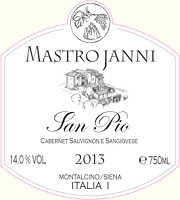
|
|
San Pio 2013 |
|
| Mastrojanni (Tuscany, Italy) | |
 Cabernet Sauvignon (80%), Sangiovese (20%) Cabernet Sauvignon (80%), Sangiovese (20%) | |
| Price: € 22.00 | Score: |
 Intense ruby red and nuances of garnet red, little transparency. Intense ruby red and nuances of garnet red, little transparency. Intense, clean, pleasing and refined, starts with hints of plum, black
currant and black cherry followed by aromas of violet, blueberry, tobacco,
vanilla, pink pepper, chocolate and vanilla. Intense, clean, pleasing and refined, starts with hints of plum, black
currant and black cherry followed by aromas of violet, blueberry, tobacco,
vanilla, pink pepper, chocolate and vanilla.
 Properly tannic attack and however balanced by alcohol, good body,
intense flavors, agreeable. Properly tannic attack and however balanced by alcohol, good body,
intense flavors, agreeable.
 Persistent finish with flavors of plum, black currant and black cherry. Persistent finish with flavors of plum, black currant and black cherry. 18 months in cask and barrique, 6 months in bottle. 18 months in cask and barrique, 6 months in bottle. |
|
 Stewed meat with mushrooms, Broiled meat and barbecue, Cheese Stewed meat with mushrooms, Broiled meat and barbecue, Cheese |
|
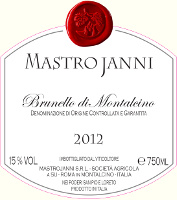
|
|
Brunello di Montalcino 2012 |
|
| Mastrojanni (Tuscany, Italy) | |
 Sangiovese Sangiovese | |
| Price: € 50.00 | Score: |
 Brilliant ruby red and nuances of garnet red, moderate transparency. Brilliant ruby red and nuances of garnet red, moderate transparency. Intense, clean, pleasing, refined and elegant, starts with hints of
black cherry, plum and violet followed by aromas of raspberry, blueberry,
blackberry, vanilla, chocolate, cinnamon and menthol. Intense, clean, pleasing, refined and elegant, starts with hints of
black cherry, plum and violet followed by aromas of raspberry, blueberry,
blackberry, vanilla, chocolate, cinnamon and menthol.
 Tannic attack and however balanced by alcohol, full body, intense
flavors, agreeable. Tannic attack and however balanced by alcohol, full body, intense
flavors, agreeable.
 Persistent finish with flavors of black cherry, plum and raspberry. Persistent finish with flavors of black cherry, plum and raspberry. 36 months in cask, 6 months in bottle. 36 months in cask, 6 months in bottle. |
|
 Game, Roasted meat, Stewed and braised meat, Hard cheese Game, Roasted meat, Stewed and braised meat, Hard cheese |
|
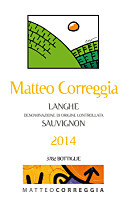
|
|
Langhe Sauvignon Matteo Correggia 2014 |
|
| Matteo Correggia (Piedmont, Italy) | |
 Sauvignon Blanc Sauvignon Blanc | |
| Price: € 22.00 | Score: |
 Brilliant straw yellow and nuances of straw yellow, very transparent. Brilliant straw yellow and nuances of straw yellow, very transparent. Intense, clean, pleasing, refined and elegant, starts with hints of
gooseberry, elder flower and peach followed by aromas of apple, green bell
pepper, pineapple, acacia, plum, grapefruit, flint, vanilla and mineral. Intense, clean, pleasing, refined and elegant, starts with hints of
gooseberry, elder flower and peach followed by aromas of apple, green bell
pepper, pineapple, acacia, plum, grapefruit, flint, vanilla and mineral.
 Crisp attack and however balanced by alcohol, good body, intense
flavors, agreeable. Crisp attack and however balanced by alcohol, good body, intense
flavors, agreeable.
 Persistent finish with flavors of gooseberry, peach and grapefruit. Persistent finish with flavors of gooseberry, peach and grapefruit. Half of this wine ages for 6 months in barrique, 10 months in steel
tanks, 12 months in bottle. Half of this wine ages for 6 months in barrique, 10 months in steel
tanks, 12 months in bottle.
|
|
 Pasta with meat, Broiled fish, Vegetable soups, Sauteed white meat Pasta with meat, Broiled fish, Vegetable soups, Sauteed white meat |
|

|
|
Roero Riserva Roche d'Ampsej 2012 |
|
| Matteo Correggia (Piedmont, Italy) | |
 Nebbiolo Nebbiolo | |
| Price: € 35.00 | Score: |
 Brilliant ruby red and nuances of garnet red, moderate transparency. Brilliant ruby red and nuances of garnet red, moderate transparency. Intense, clean, pleasing, refined and elegant, starts with hints of
cherry, plum and violet followed by aromas of raspberry, rose, strawberry,
vanilla, cinnamon, tobacco, pink pepper, cocoa, licorice, leather and
menthol. Intense, clean, pleasing, refined and elegant, starts with hints of
cherry, plum and violet followed by aromas of raspberry, rose, strawberry,
vanilla, cinnamon, tobacco, pink pepper, cocoa, licorice, leather and
menthol.
 Tannic attack and however balanced by alcohol, full body, intense
flavors, pleasing crispness. Tannic attack and however balanced by alcohol, full body, intense
flavors, pleasing crispness.
 Very persistent finish with long flavors of cherry, plum and raspberry. Very persistent finish with long flavors of cherry, plum and raspberry. 18 months in cask and barrique, 24 months in bottle. 18 months in cask and barrique, 24 months in bottle. |
|
 Game, Roasted meat, Stewed and braised meat, Hard cheese Game, Roasted meat, Stewed and braised meat, Hard cheese |
|
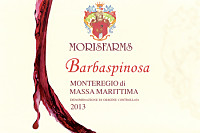
|
|
Monteregio di Massa Marittima Rosso Barbaspinosa 2013 |
|
| Moris Farms (Tuscany, Italy) | |
 Sangiovese (90%), Cabernet Sauvignon (10%) Sangiovese (90%), Cabernet Sauvignon (10%) | |
| Price: € 12.90 | Score: |
 Intense ruby red and nuances of ruby red, little transparency. Intense ruby red and nuances of ruby red, little transparency. Intense, clean, pleasing and refined, starts with hints of black
cherry, black currant and plum followed by aromas of violet, blueberry,
tobacco, vanilla, blackberry, chocolate and menthol. Intense, clean, pleasing and refined, starts with hints of black
cherry, black currant and plum followed by aromas of violet, blueberry,
tobacco, vanilla, blackberry, chocolate and menthol.
 Properly tannic attack and however balanced by alcohol, good body,
intense flavors, pleasing roundness. Properly tannic attack and however balanced by alcohol, good body,
intense flavors, pleasing roundness.
 Persistent finish with flavors of black cherry, black currant and plum. Persistent finish with flavors of black cherry, black currant and plum. 18 months in barrique. 18 months in barrique. |
|
 Roasted meat, Stewed and braised meat with mushrooms, Hard cheese Roasted meat, Stewed and braised meat with mushrooms, Hard cheese |
|
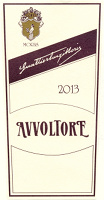
|
|
Avvoltore 2013 |
|
| Moris Farms (Tuscany, Italy) | |
 Sangiovese (75%), Cabernet Sauvignon (20%), Syrah (5%) Sangiovese (75%), Cabernet Sauvignon (20%), Syrah (5%) | |
| Price: € 32.00 | Score: |
 Intense ruby red and nuances of garnet red, little transparency. Intense ruby red and nuances of garnet red, little transparency. Intense, clean, pleasing, refined and elegant, starts with hints of
black currant, black cherry and blackberry followed by aromas of violet,
plum, vanilla, raspberry, blackberry, tobacco, chocolate, peony, face
powder, pink pepper, mace and menthol. Intense, clean, pleasing, refined and elegant, starts with hints of
black currant, black cherry and blackberry followed by aromas of violet,
plum, vanilla, raspberry, blackberry, tobacco, chocolate, peony, face
powder, pink pepper, mace and menthol.
 Tannic attack and however balanced by alcohol, full body, intense
flavors, pleasing roundness. Tannic attack and however balanced by alcohol, full body, intense
flavors, pleasing roundness.
 Very persistent with long flavors of black currant, black cherry and
blueberry. Very persistent with long flavors of black currant, black cherry and
blueberry.
 12 months in barrique, 6 months in bottle. 12 months in barrique, 6 months in bottle. |
|
 Game, Roasted meat, Braised and stewed meat, Hard cheese Game, Roasted meat, Braised and stewed meat, Hard cheese |
|
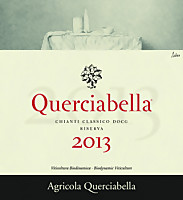
|
|
Chianti Classico Riserva 2013 |
|
| Querciabella (Tuscany, Italy) | |
 Sangiovese Sangiovese | |
| Price: € 38.00 | Score: |
 Intense ruby red and nuances of ruby red, little transparency. Intense ruby red and nuances of ruby red, little transparency. Intense, clean, pleasing, refined and elegant, starts with hints of
black cherry, plum and violet followed by aromas of blueberry, raspberry,
blackberry, vanilla, chocolate, tobacco, cinnamon, mace and menthol. Intense, clean, pleasing, refined and elegant, starts with hints of
black cherry, plum and violet followed by aromas of blueberry, raspberry,
blackberry, vanilla, chocolate, tobacco, cinnamon, mace and menthol.
 Properly tannic attack and however balanced by alcohol, good body,
intense flavors, pleasing crispness. Properly tannic attack and however balanced by alcohol, good body,
intense flavors, pleasing crispness.
 Persistent finish with flavors of black cherry, plum and raspberry. Persistent finish with flavors of black cherry, plum and raspberry. 16 months in cask. 16 months in cask. |
|
 Broiled meat and barbecue, Roasted meat, Stewed meat with mushrooms, Hard cheese Broiled meat and barbecue, Roasted meat, Stewed meat with mushrooms, Hard cheese |
|
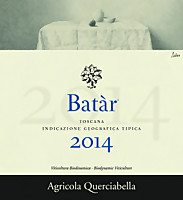
|
|
Batàr 2014 |
|
| Querciabella (Tuscany, Italy) | |
 Chardonnay (50%), Pinot Bianco (50%) Chardonnay (50%), Pinot Bianco (50%) | |
| Price: € 75.00 | Score: |
 Brilliant golden yellow and nuances of golden yellow, very transparent. Brilliant golden yellow and nuances of golden yellow, very transparent. Intense, clean, pleasing, refined and elegant, starts with hints of
apple, banana and plum followed by aromas of hawthorn, grapefruit, ripe
peach, butter, broom, vanilla, bergamot, praline, honey, mango, graphite
and mineral. Intense, clean, pleasing, refined and elegant, starts with hints of
apple, banana and plum followed by aromas of hawthorn, grapefruit, ripe
peach, butter, broom, vanilla, bergamot, praline, honey, mango, graphite
and mineral.
 Crisp attack and however balanced by alcohol, full body, intense
flavors, pleasing roundness. Crisp attack and however balanced by alcohol, full body, intense
flavors, pleasing roundness.
 Very persistent finish with long flavors of apple, banana and plum. Very persistent finish with long flavors of apple, banana and plum. Fermented in barrique, 9 months in barrique. Fermented in barrique, 9 months in barrique. |
|
 Roasted fish, Stuffed pasta with mushrooms, Roasted white meat, Stewed white meat Roasted fish, Stuffed pasta with mushrooms, Roasted white meat, Stewed white meat |
|
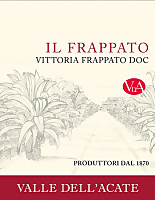
|
|
Vittoria Frappato 2016 |
|
| Valle dell'Acate (Sicily, Italy) | |
 Frappato Frappato | |
| Price: € 12.50 | Score: |
 Brilliant ruby red and nuances of ruby red, moderate transparency. Brilliant ruby red and nuances of ruby red, moderate transparency. Intense, clean, pleasing and refined, starts with hints of cherry,
blackberry and raspberry followed by aromas of strawberry, cyclamen, rose,
plum, blueberry and black pepper. Intense, clean, pleasing and refined, starts with hints of cherry,
blackberry and raspberry followed by aromas of strawberry, cyclamen, rose,
plum, blueberry and black pepper.
 Properly tannic attack and however balanced by alcohol, good body,
intense flavors, pleasing crispness. Properly tannic attack and however balanced by alcohol, good body,
intense flavors, pleasing crispness.
 Persistent finish with flavors of cherry, raspberry and strawberry. Persistent finish with flavors of cherry, raspberry and strawberry. 6 months in steel tanks, 3 months in bottle. 6 months in steel tanks, 3 months in bottle. |
|
 Cold cuts, Pasta with meat and mushrooms, Sauteed meat, Fish soups Cold cuts, Pasta with meat and mushrooms, Sauteed meat, Fish soups |
|
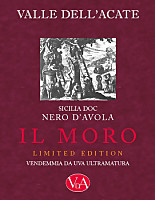
|
|
Il Moro Limited Edition 2012 |
|
| Valle dell'Acate (Sicily, Italy) | |
 Nero d'Avola Nero d'Avola | |
| Price: € 16.00 | Score: |
 Intense ruby red and nuances of garnet red, little transparency. Intense ruby red and nuances of garnet red, little transparency. Intense, clean, pleasing, refined and elegant, starts with hints of
blackberry, plum and black cherry followed by aromas of dried violet,
blueberry, vanilla, chocolate, leather, mace, licorice, tobacco and
menthol. Intense, clean, pleasing, refined and elegant, starts with hints of
blackberry, plum and black cherry followed by aromas of dried violet,
blueberry, vanilla, chocolate, leather, mace, licorice, tobacco and
menthol.
 Properly tannic attack and however balanced by alcohol, good body,
intense flavors, pleasing roundness. Properly tannic attack and however balanced by alcohol, good body,
intense flavors, pleasing roundness.
 Persistent finish with flavors of blackberry, plum and black cherry. Persistent finish with flavors of blackberry, plum and black cherry. 12 months in barrique, at least 60 months in bottle. 12 months in barrique, at least 60 months in bottle. |
|
 Broiled meat and barbecue, Stewed meat with mushrooms, Roasted meat, Hard cheese Broiled meat and barbecue, Stewed meat with mushrooms, Roasted meat, Hard cheese |
|
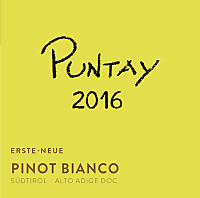
|
|
Alto Adige Pinot Bianco Puntay 2016 |
|
| Erste+Neue (Alto Adige, Italy) | |
 Pinot Bianco Pinot Bianco | |
| Price: € 15.00 | Score: |
 Pale straw yellow and nuances of straw yellow, very transparent. Pale straw yellow and nuances of straw yellow, very transparent. Intense, clean, pleasing and refined, starts with hints of apple, pear
and hawthorn followed by aromas of plum, citrus fruits, broom, pineapple,
jasmine and peach. Intense, clean, pleasing and refined, starts with hints of apple, pear
and hawthorn followed by aromas of plum, citrus fruits, broom, pineapple,
jasmine and peach.
 Crisp attack and however balanced by alcohol, good body, intense
flavors, pleasing roundness. Crisp attack and however balanced by alcohol, good body, intense
flavors, pleasing roundness.
 Persistent finish with flavors of apple, pear and plum. Persistent finish with flavors of apple, pear and plum. 7 months in cask. 7 months in cask. |
|
 Fish appetizers, Pasta with crustaceans, Sauteed white meat, Vegetable flans, Dairy products Fish appetizers, Pasta with crustaceans, Sauteed white meat, Vegetable flans, Dairy products |
|
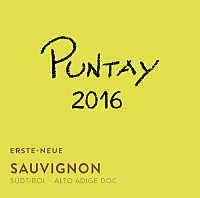
|
|
Alto Adige Sauvignon Puntay 2016 |
|
| Erste+Neue (Alto Adige, Italy) | |
 Sauvignon Blanc Sauvignon Blanc | |
| Price: € 15.00 | Score: |
 Intense greenish yellow and nuances of greenish yellow, very
transparent. Intense greenish yellow and nuances of greenish yellow, very
transparent.
 Intense, clean, pleasing and refined, starts with hints of gooseberry,
peach and nettle followed by aromas of elder flower, banana, pear, broom,
apple, lemon and grapefruit. Intense, clean, pleasing and refined, starts with hints of gooseberry,
peach and nettle followed by aromas of elder flower, banana, pear, broom,
apple, lemon and grapefruit.
 Crisp attack and however balanced by alcohol, good body, intense
flavors, agreeable. Crisp attack and however balanced by alcohol, good body, intense
flavors, agreeable.
 Persistent finish with flavors of gooseberry, peach and banana. Persistent finish with flavors of gooseberry, peach and banana. 7 months in cask. 7 months in cask. |
|
 Crustacean appetizers, Risotto with vegetable and fish, Fried fish, Dairy products, Eggs Crustacean appetizers, Risotto with vegetable and fish, Fried fish, Dairy products, Eggs |
|
|
||||||||
|
DiWineTaste Polls
|
| |||||||
Privacy Policy | |||||||


| Copyright © 2002-2024 Antonello Biancalana, DiWineTaste - All rights reserved |
| All rights reserved under international copyright conventions. No part of this publication and of this WEB site may be
reproduced or utilized in any form or by any means, electronic or mechanical, without permission in writing from DiWineTaste. |